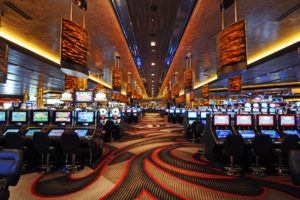Blackjack is a casino game that is played against the house. In this case, all players are up against the dealer. If their hand wins, they scoop the bet. If the dealer’s hand wins or players go bust, the house takes the bet.
Blackjack, however, is a little different to most casino games, because there are certain ways to play that can improve your chances. Applying basic strategy can actually reduce the house edge from an average of around 2 percent, to as little as 0.5 percent.
The house edge in a casino can actually be further reduced, or even negated, using card counting techniques. These techniques are very difficult to master, are frowned upon at most casinos, and can’t be applied to online blackjack. Therefore, this article will stick to providing tips on reducing the house edge using strategy that can be applied to any game.
1. Learn the Rules
First of all, it’s important to master the rules of blackjack before placing any significant bets. Blackjack is not a difficult game to learn, and knowing the rules will help the game to flow better and set you up for using these tips to reduce the house edge.
In blackjack, the dealer gives each player two cards and deals themselves two cards, one face up and one face down. The aim of the game is make 21, or as close to it as possible, without going over and going bust. Making 21 in two cards is known as a “blackjack”.
Remember, you’re up against the dealer, so the card that they have showing will determine whether you should draw for more cards or stand with what you have.
Players also have the option to Split when they have two cards of the same rank, and play these hands individually. Another option is to Double the bet size, which is usually a play available when your hand is valued at 10 or 11.
Blackjack rules tend to vary according to region or casino, so be sure to familiarize yourself with the rules for the particular game you’re playing.
2. Utilize Basic Strategy Charts
Understanding the rules of blackjack and knowing the rule variations that you’ll be playing, you can begin to study blackjack basic strategy charts. These charts can be overwhelming at first, but they are the key to knowing exactly what move to make and when to make it.
It may seem boring to see blackjack solved in charts, but the truth is these charts are based on the mathematics needed to reduce the house edge. Each solution derives from a calculation designed to give you the best odds of beating the dealer’s hand given their visible up-card.
Some casinos may let you take these cards in with you, or even sit with them at the tables. The casino still has an edge, after all, so using these charts is not known as cheating. Other casinos, however, may not let you sit at the table with the cards. So your job is to memorize the charts as much as possible.

3. Quickfire Blackjack Tips
There are many other situations to learn that are more complex and depend more on the dealer’s card as a factor. These are across the board tips that can quickly be applied. Studying the charts will teach you more.
- Don’t take the insurance bet. Insurance is a bet you can make that protects you against the dealer making blackjack. Some players think that it’s wise to take it if the dealer is showing a strong up-card, such as a ten or ace. In truth, the payoff of 2-1 on this bet is less than the odds of the dealer turning blackjack.
- Always split eights and aces. This is because in the case of splitting aces you will create two very strong starting hands, resulting in more expected gains. In the case of a pair of eights, splitting the 16 into two 8s is a way of cutting your losses with a bad hand. Conversely, you should never split tens or fives – both player stronger kept as a single hand.
- As a general rule (there are very specific cases that change this), you should always Double when you have a hard 11, no matter what the dealer is showing. You should also Double with a 10 if the dealer is showing 9 or less. In both cases, you’re in the best position to up your stake.
- Always Stand on hard 17 (hard meaning a hand without an ace). Always Hit when you have 5-7 – you’ll also be hitting or doubling anything up to 11 no matter what, so never Stand before 12.
4. Card Counting?
Using basic strategy tips like those described above reduced the house edge in blackjack, but the casino does still have an edge. So, what about the stories of groups of students taking casinos for millions of dollars? That’s where card counting comes in.
Card counting involves using any system to track which cards have been dealt and therefore which cards are still in the deck, usually categorizing them as either high or low by adding or subtracting “1” every time you see a card.
Again, it’s very difficult to learn and even more difficult to master. And, although not technically illegal, it’s very frowned upon and is likely to get you banned from most casinos. It’s also not possible online.
So, unless you’re looking to be the next Lawrence Revere, stick to the blackjack charts and basic strategy.






 Your total news and information resource for all things Science, Technology, Engineering / Mathematics, Art, and Medicine / Health.
Your total news and information resource for all things Science, Technology, Engineering / Mathematics, Art, and Medicine / Health.
Leave a Comment